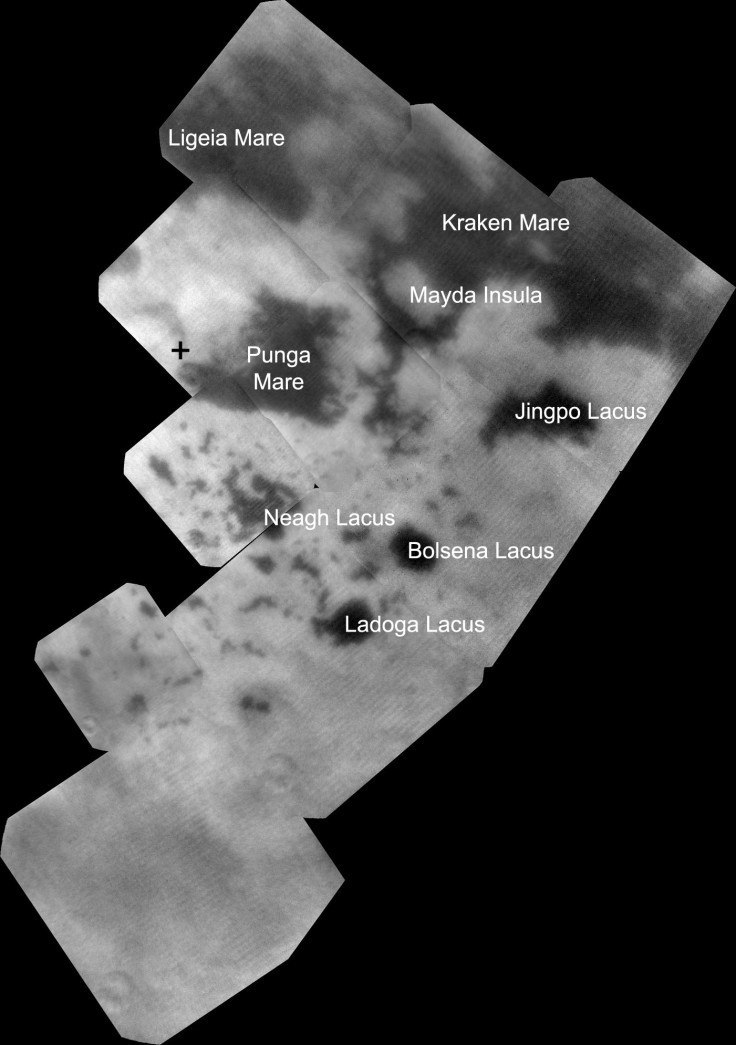Waves Spotted On Titan? Cassini Images Suggest Saturn’s Largest Moon ‘May Be Beginning To Stir’

Saturn’s largest moon may be millions of miles away from Earth, but it has some eerie similarities to our world.
Planetary scientists believe they have observed waves rippling on Titan’s seas. The findings, presented Monday at the Lunar and Planetary Science Conference, describes how the Cassini spacecraft captured images of sunlight glinting off the Punga Mare, suggesting they are not reflective sunlight but waves, Nature reports.
“Titan may be beginning to stir,” Ralph Lorenz, a planetary scientist at the Johns Hopkins University Applied Physics Laboratory in Laurel, Md., told Nature. “Oceanography is no longer just an Earth science.”
Small lakes and seas have been spotted on Titan in the past. The Cassini spacecraft has revealed that the moon’s surface is shaped by rivers and lakes of liquid ethane and methane. These components, which are found in natural gas, create clouds that sometimes result in rain fall from the sky, much as it does on Earth. The moon is one of the most “Earth-like” worlds scientists have found. It resembles Earth as it was several billions of years ago – frozen before life began distributing oxygen into the atmosphere.
The latest discovery stems from images captured by the Cassini spacecraft in 2012 and 2013. The images that show sunlight sparking off the sea’s surface were examined. Four pixels in the images are brighter than what would be seen with ordinary reflective sunlight, Barnes said. If the observations are in fact waves and not mudflats, then they would be about 2 centimeters (0.39 inches) high.
“If correct this discovery represents the first sea-surface waves known outside of Earth,” the authors of the study write. “That they have previously been undetected and are now evident is consistent with the Lorenz et al. hypothesis that winds had previously been low due to seasonal cycles but are picking up as northern spring develops.”
Despite the latest findings, Barnes reiterates that they are preliminary. “Don’t make your surfing plane reservation for Titan just yet,” he said.
This isn’t the first time scientists have spotted something questionable on Titan’s seas. Last summer, scientists said they saw a “magic island” on Ligeia Mare, the second-largest sea on Titan. Sixteen days after the image was taken, the object disappeared. The team later concluded that the island was most likely a set of waves or bubbles.
Titian, which is about 1.5 times larger than Earth’s moon, has about 2,000 cubic miles of liquid methane and ethane on its frozen surface. So far, 32 lakes have been identified on Titan.
The Cassini spacecraft, which arrived at Saturn in 2004, has made its 100th flyby over Titian on March 5. The NASA mission has identified lakes, rivers and water underneath the moon’s surface. Radar has also been used to determine the depth of Ligeia Mare at 525 feet deep. The moon’s Earth-like atmosphere suggests the possibility that it can sustain life.
“Methane is not only in the atmosphere, but probably in the crust,” Jonathan Lunine, a scientist on the Cassini mission at Cornell University, said in a statement. “It’s a hint there are organics not only in Titan’s air and on the surface, but even in the deep interior, where liquid water exists as well. Organics are the building blocks of life, and if they are in contact with liquid water, there could be a chance of finding some form of life.”
© Copyright IBTimes 2024. All rights reserved.






















